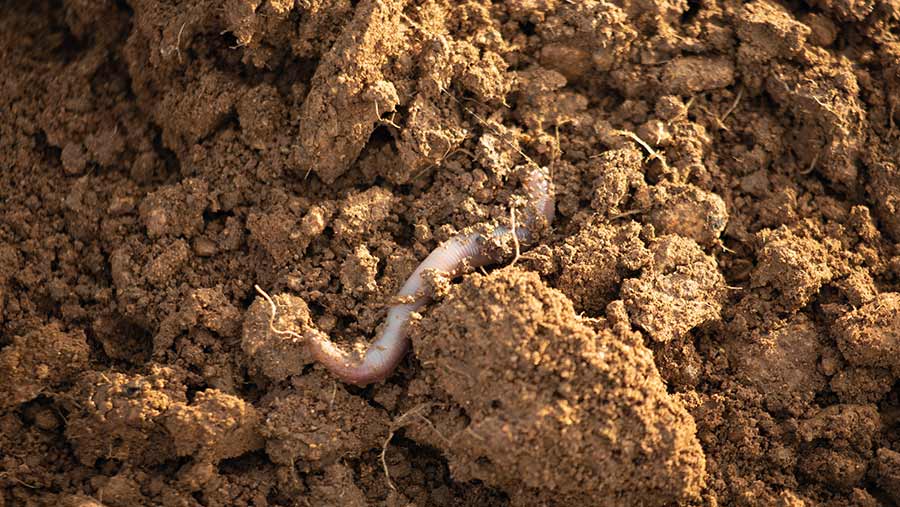5 fundamentals to achieve healthy soils
 © Tim Scrivener
© Tim Scrivener Healthy soil is a farm’s number one asset, and is critical to growing crops and livestock, enriching ecosystems, sequestering carbon and preventing flooding. But what does healthy soil look like?
Independent grassland and soil consultant Gareth Davies says farmers should be thinking about farming the life below the soil as well as the life above it.
“Soil needs a good supply of water, air and feed, just like the animals above the surface.
“There should be a cycle whereby the farmer looks after the soil, the soil looks after the plant, the plant looks after the animal and the animal looks after the farmer.”
Below, he advises what constitutes healthy soil and why these factors are so important to the way soil functions.
1. Physical health (structure and smell)
Why it is important
Healthy soil should have plenty of air spaces to maintain aerobic conditions. This is important to improve the function of biology and carbon-holding capacity, which is the driving engine for our soils, feeding fungi and microbes that help plants grow.
What to look for
Healthy soil should have a good mix of aggregates, break apart easily, have deep roots (at least the depth of the spade), have plenty of worms and have a good, earthy smell.
Target
Easily crumbled, light brown colour, good, earthy smell, worms.
See also: Advice on establishing and grazing herbal leys
2. Organic matter content
What it is and why it’s important
Soil organic matter is made up of plant residue and animal tissue at varying stages of decomposition. Organic matter comprises 50% carbon. For every 1% increase in organic matter, 0.4ha (one acre) of soils draws down 10 times more carbon from our atmosphere. Furthermore, for every 1% increase in soil organic matter, the soil can hold an extra 70,000 litres of water/ha.
Good organic matter has a number of other benefits, including:
- Enhancing pore spaces, which improves water infiltration and aeration
- Providing food for living organisms in the soil
- Enhancing soil biodiversity
- Reducing disease and pests.
What to look for
An in-depth soil test is required to test the organic matter of your soils.
Digging holes can also give you an indication. Dig one close to a hedge and one in the middle of the field. Compare the colour of the two. Most of the time, the sample taken from nearest the hedge is darker in colour, which indicates higher organic matter. That can show how practices on that field may have reduced the organic matter over time and can challenge you to return it to the previous colour.
Target
Soil organic matter ranges from 1% (mostly deserts) to 5-10% in lots of agricultural, depending on your soil type. It is generally lower on lighter soils.
Ideally, soil organic matter needs to be more than 3%, otherwise the soil doesn’t contribute to crop growth. You should aim to increase organic matter and test regularly (every two years) to track progress.
3. Biodiversity and biology
What it is and why it’s important
Soil biodiversity relates to the range of living organisms in the soil. In healthy soil, the liveweight below the surface should equal that above the surface.
Plants leak liquid carbon into the root zone. The mycorrhizal fungi can’t get enough of this and, in exchange, they feed the plant with nutrients to help it grow.
What to look for and targets
Dig a hole (20sq cm) and look at the following:
- Worms – a spade of soil should contain 10+ earthworms (with a good mix of sizes)
- Compaction (see “Water infiltration and retention” below)
- How far the roots extend (ideally spade depth)
- Wormcasts should be visible (they look like mini mole hills)
- Dung beetles should visibly be breaking down old dung pats.
See also: A six-step guide to assessing soil compaction

© Shutterstock/FLPA
4. Chemical health
What it is and why it is important
Soil chemistry covers the elements and compounds required for plant growth.
These have a direct effect on soil structure and biology, and are key in providing vital nutrients for the soil organisms and plants. For example, if some are too high, they have a detrimental effect on soil biology. The availability of chemical elements will vary according to soil type and composition.
What to look for
The targets are dependent on a range of factors, including soil type, pH, organic matter and cation exchange. Know the element status of you soils by carrying out an in-depth soil test and discussing this with your agronomist.
Target 6.2-6.5pH
5. Water infiltration and retention
What it is and why it’s important
Compaction is one of the biggest issues farmers face and can be a huge barrier to water and root infiltration. Water should work its way into the soil to lower surface water levels, encourage deep rooting and create good living conditions deep in the soil. Improved water retention also helps offset drought.
Target
The potential water-holding capacity is indicated by the soil organic matter, but you need good infiltration to see the benefits. If the water doesn’t infiltrate more than the top 7-14cm, you won’t see these benefits.
In the next article in the series, we will look at what practices can improve soil quality and carbon-loading capacity.
